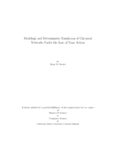- DSpace Home
- →
- Channel Islands
- →
- Academic Affairs
- →
- Masters Theses and Projects
- →
- Computer Science
JavaScript is disabled for your browser. Some features of this site may not work without it.
| dc.contributor.author | Brown, Ryan M. | en |
| dc.date.accessioned | 2008-07-17T23:33:40Z | en |
| dc.date.available | 2008-07-17T23:33:40Z | en |
| dc.date.issued | 2008-05 | en |
| dc.identifier.uri | http://hdl.handle.net/10139/503 | en |
| dc.description.abstract | Mass Action Kinetics refers to the supposition that the probability of chemical components reacting is proportional to their concentrations, with the rate constant taken as the constant of proportionality. We state a commonly used set-theoretic language for describing chemical networks and discuss the Law of Mass Action. Assuming a set of chemical substances react within a fluid mixture, isolated from the external universe, Mass Action Kinetics is used to model the time evolution of species within the system by nonlinear differential equations. Because these differential equations are considered stiff equations, comparative analysis of numerical methods shows that stiffness greatly determines the quality of computation. Specifically, a Taylor Series Method is comparable to both implicit and explicit Runge-Kutta Methods, though for stiff instances is inadequate. Examples demonstrating this contrast are provided, showing the need for caution when choosing a numerical integration technique. | en |
| dc.language.iso | en_US | en |
| dc.rights | All rights reserved to author and California State University Channel Islands | en |
| dc.subject | Modeling | en |
| dc.subject | Numerical methods | en |
| dc.subject | Chemical networks | en |
| dc.subject | Taylor | en |
| dc.subject | Mass action | en |
| dc.subject | Computer Science thesis | en |
| dc.title | Modeling and Deterministic Simulation of Chemical Networks Under the Law of Mass Action | en |
| dc.type | Thesis | en |
Files in this item
This item appears in the following Collection(s)
-
Computer Science [55]

